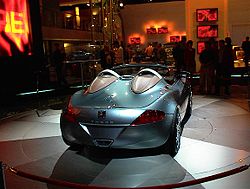| SEAT Tango | |
|---|---|
 | |
| Overview | |
| Manufacturer | SEAT, SA |
| Production | 2001 |
| Designer | Walter de Silva |
| Body and chassis | |
| Class | Concept car, sports car |
| Body style | 2-door 2-seat roadster |
| Layout | front engine transverse |
| Powertrain | |
| Engine | 1.8 L (110 cu in) 20 valve Turbocharged I4, DOHC |
| Transmission | 6-speed manual |
| Dimensions | |
| Wheelbase | 2,200 mm (86.6 in) |
| Length | 3,685 mm (145.1 in) |
| Width | 1,714 mm (67.5 in) |
| Height | 1,181 mm (46.5 in) |
| Curb weight | 1,150 kg (2,540 lb) |
The SEAT Tango roadster is a concept car presented at the 2001 Frankfurt Motor Show, designed by a team directed by Walter de Silva with the contribution of SEAT's chief of exterior design, Steve Lewis. [1]
Contents
- Potential production
- Awards
- Engine
- Suspension, brakes and tires
- Exterior dimensions and weight
- Performance
- Derivatives
- External links
- References
Featuring a two-door two-seater roadster body style riding on a cut-down SEAT Ibiza platform, it is powered by a 180 PS (132 kW; 178 hp) version of Volkswagen Group's 1.8L 20VT engine which drives the front wheels. While it was an internal concept, it was originally intended to be called the Tanga because of its rear end lines, however that name was turned down by Volkswagen Group's management as it was found rather provocative. [2]
Extensive safety measures were also integrated into the project: in addition to the progressive deformation structure and central passenger cell which help to cushion impact, it was also equipped with twin front airbags, side airbags, Antilock Braking System, Electronic Stability Control and Traction Control systems.

